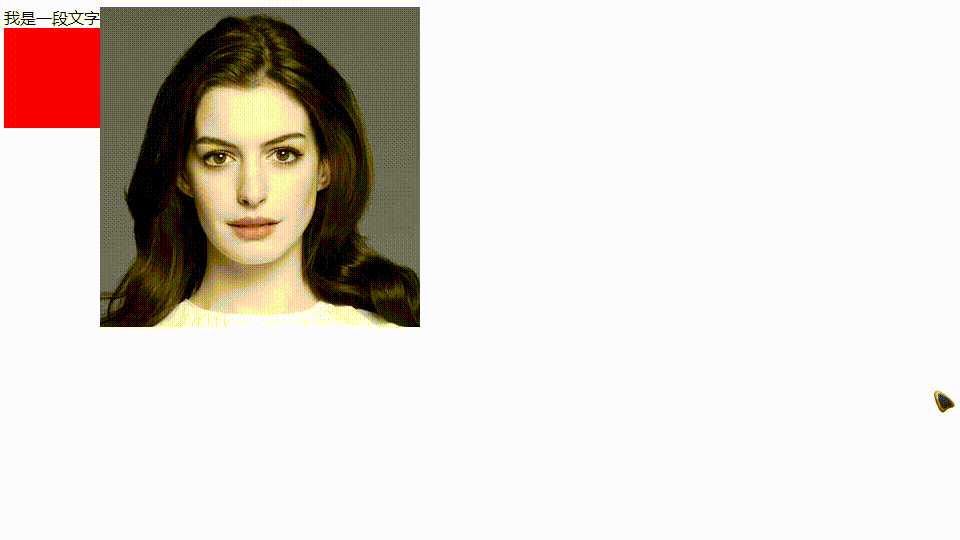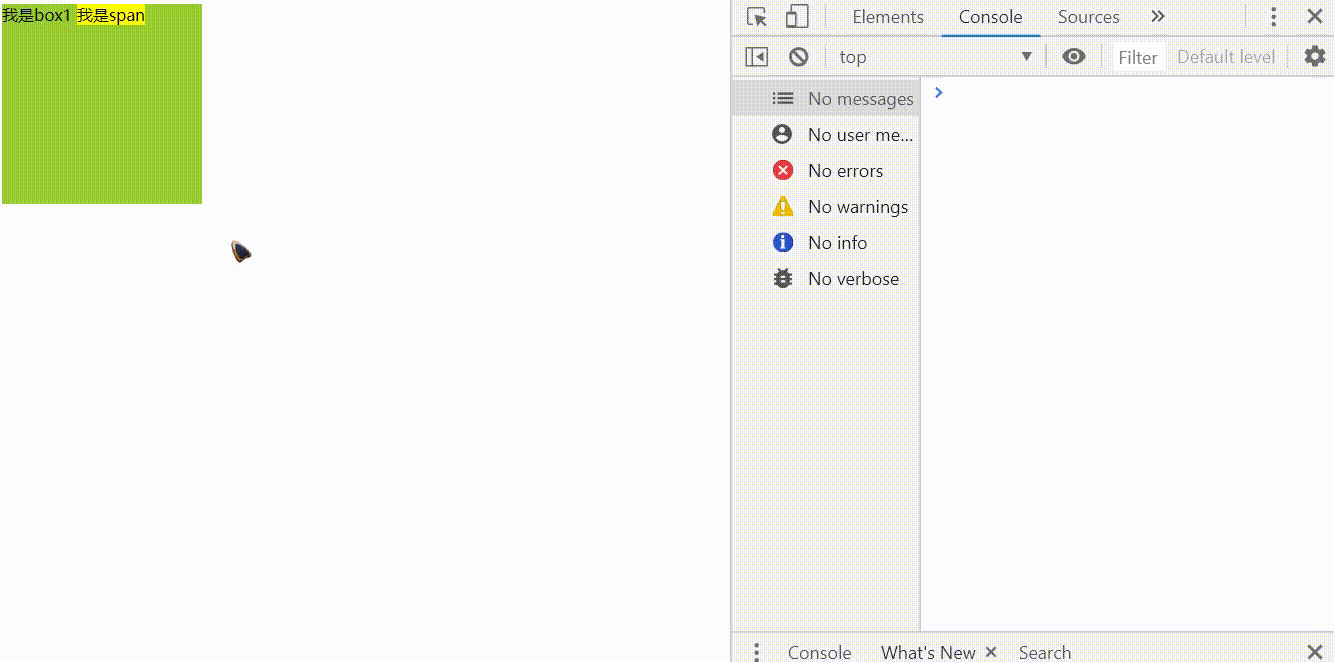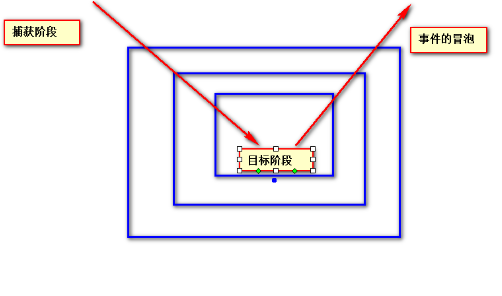事件的冒泡(Bubble)
- 所谓的冒泡指的就是事件的向上传导,当后代元素上的事件被触发时,其祖先元素的相同事件也会被触发
- 在开发中大部分情况冒泡都是有用的,如果不希望发生事件冒泡可以通过事件对象来取消冒泡
<!DOCTYPE html> <html> <head> <meta charset="UTF-8"> <title></title> <style type="text/css"> #box1{ width: 200px; height: 200px; background-color: yellowgreen; } #s1{ background-color: yellow; } </style> <script type="text/javascript"> window.onload = function(){ //为s1绑定一个单击响应函数 var s1 = document.getElementById("s1"); s1.onclick = function(event){ event = event || window.event; con("我是span的单击响应函数"); }; //为box1绑定一个单击响应函数 var box1 = document.getElementById("box1"); box1.onclick = function(event){ event = event || window.event; alert("我是div的单击响应函数"); }; //为body绑定一个单击响应函数 document.body.onclick = function(){ alert("我是body的单击响应函数"); }; }; </script> </head> <body> <div id="box1"> 我是box1 <span id="s1">我是span</span> </div> </body> </html>
可以发现,点击
div会同时触发div与body的点击事件,点击span会同时触发div与body的点击事件,这就是一种事件的冒泡,而想组织此事件的冒泡只需要添加一个属性即可解决。
移除冒泡
可以将事件对象的
cancelBubble设置为true,即可取消冒泡<!DOCTYPE html> <html> <head> <meta charset="UTF-8"> <title></title> <style type="text/css"> #box1{ width: 200px; height: 200px; background-color: yellowgreen; } #s1{ background-color: yellow; } </style> <script type="text/javascript"> window.onload = function(){ //为s1绑定一个单击响应函数 var s1 = document.getElementById("s1"); s1.onclick = function(event){ event = event || window.event; console.log("我是span的单击响应函数"); //取消冒泡 //可以将事件对象的cancelBubble设置为true,即可取消冒泡 event.cancelBubble = true; }; //为box1绑定一个单击响应函数 var box1 = document.getElementById("box1"); box1.onclick = function(event){ event = event || window.event; console.log("我是div的单击响应函数"); event.cancelBubble = true; }; //为body绑定一个单击响应函数 document.body.onclick = function(){ console.log("我是body的单击响应函数"); }; }; </script> </head> <body> <div id="box1"> 我是box1 <span id="s1">我是span</span> </div> </body> </html>
通过设置
event.cancelBubble = true;以后,可以发现,移除了事件的冒泡
冒泡示例
<!DOCTYPE html>
<html>
<head>
<meta charset="UTF-8">
<title></title>
<style type="text/css">
#box1{
width: 100px;
height: 100px;
background-color: red;
/*
* 开启box1的绝对定位
*/
position: absolute;
}
</style>
<script type="text/javascript">
window.onload = function(){
/*
* 使div可以跟随鼠标移动
*/
//获取box1
var box1 = document.getElementById("box1");
//绑定鼠标移动事件
document.onmousemove = function(event){
//解决兼容问题
event = event || window.event;
//获取滚动条滚动的距离
/*
* chrome认为浏览器的滚动条是body的,可以通过body.scrollTop来获取
* 火狐等浏览器认为浏览器的滚动条是html的,
*/
var st = document.body.scrollTop || document.documentElement.scrollTop;
var sl = document.body.scrollLeft || document.documentElement.scrollLeft;
//获取到鼠标的坐标
/*
* clientX和clientY
* 用于获取鼠标在当前的可见窗口的坐标
* div的偏移量,是相对于整个页面的
*/
var left = event.clientX;
var top = event.clientY;
//设置div的偏移量
box1.style.left = left + sl + "px";
box1.style.top = top + st + "px";
};
var box2 = document.getElementById("box2");
box2.onmousemove = function(event){
event = event || window.event;
};
};
</script>
</head>
<body style="height: 1000px;width: 2000px;">
<div id="box2" style="width: 500px; height: 500px; background-color: #bfa;"></div>
<div id="box1"></div>
</body>
</html>
允许事件冒泡
组织事件冒泡
添加代码
event.cancelBubble = true;
组织冒泡以后,大盒子不再同时响应事件,因此,红色盒子无法穿越进去
事件的委派
指将事件统一绑定给元素的共同的祖先元素,这样当后代元素上的事件触发时,会一直冒泡到祖先元素,从而通过祖先元素的响应函数来处理事件。
事件委派是利用了冒泡,通过委派可以减少事件绑定的次数,提高程序的性能
示例:
<!DOCTYPE html> <html> <head> <meta charset="utf-8" /> <title></title> <script type="text/javascript"> window.onload = function(){ var u1 = document.getElementById("u1"); //点击按钮以后添加超链接 var btn01 = document.getElementById("btn01"); btn01.onclick = function(){ //创建一个li var li = document.createElement("li"); li.innerHTML = "<a href='javascript:;' class='link'>新建的超链接</a>"; //将li添加到ul中 u1.appendChild(li); }; //为ul绑定一个单击响应函数 u1.onclick = function(event){ event = event || window.event; /* * target * - event中的target表示的触发事件的对象 */ //如果触发事件的对象是我们期望的元素,则执行否则不执行 if(event.target.className == "link"){ alert("我是ul的单击响应函数"); } }; }; </script> </head> <body> <button id="btn01">添加超链接</button> <ul id="u1" style="background-color: #bfa;"> <li> <p>我是p元素</p> </li> <li><a href="javascript:;" class="link">超链接一</a></li> <li><a href="javascript:;" class="link">超链接二</a></li> <li><a href="javascript:;" class="link">超链接三</a></li> </ul> </body> </html>
事件的传播
关于事件的传播网景公司和微软公司有不同的理解
微软公司微软公司认为事件应该是由内向外传播,也就是当事件触发时,应该先触发当前元素上的事件,然后再向当前元素的祖先元素上传播,也就说事件应该在冒泡阶段执行。
网景公司网景公司认为事件应该是由外向内传播的,也就是当前事件触发时,应该先触发当前元素的最外层的祖先元素的事件,然后在向内传播给后代元素
W3CW3C综合了两个公司的方案,将事件传播分成了三个阶段
- 捕获阶段
- 在捕获阶段时从最外层的祖先元素,向目标元素进行事件的捕获,但是默认此时不会触发事件
- 目标阶段
- 事件捕获到目标元素,捕获结束开始在目标元素上触发事件
- 冒泡阶段
- 如果希望在捕获阶段就触发事件,可以将addEventListener()的第三个参数设置为true(
一般情况下我们不会希望在捕获阶段触发事件,所以这个参数一般都是false)IE8及以下的浏览器中没有捕获阶段
<!DOCTYPE html> <html> <head> <meta charset="UTF-8"> <title></title> <style type="text/css"> #box1{ width: 300px; height: 300px; background-color: yellowgreen; } #box2{ width: 200px; height: 200px; background-color: yellow; } #box3{ width: 150px; height: 150px; background-color: skyblue; } </style> <script type="text/javascript"> window.onload = function(){ /* * 分别为三个div绑定单击响应函数 */ var box1 = document.getElementById("box1"); var box2 = document.getElementById("box2"); var box3 = document.getElementById("box3"); bind(box1,"click",function(){ alert("我是box1的响应函数") }); bind(box2,"click",function(){ alert("我是box2的响应函数") }); bind(box3,"click",function(){ alert("我是box3的响应函数") }); }; function bind(obj , eventStr , callback){ if(obj.addEventListener){ //大部分浏览器兼容的方式 obj.addEventListener(eventStr , callback , true); }else{ //IE8及以下 obj.attachEvent("on"+eventStr , function(){ //在匿名函数中调用回调函数 callback.call(obj); }); } } </script> </head> <body> <div id="box1"> <div id="box2"> <div id="box3"></div> </div> </div> </body> </html>
拖拽实例
<!DOCTYPE html>
<html>
<head>
<meta charset="UTF-8">
<title></title>
<style type="text/css">
#box1{
width: 100px;
height: 100px;
background-color: red;
position: absolute;
}
#box2{
width: 100px;
height: 100px;
background-color: yellow;
position: absolute;
left: 200px;
top: 200px;
}
</style>
<script type="text/javascript">
window.onload = function(){
//获取box1
var box1 = document.getElementById("box1");
var box2 = document.getElementById("box2");
var img1 = document.getElementById("img1");
//开启box1的拖拽
drag(box1);
//开启box2的
drag(box2);
//开启img1的
drag(img1);
};
/*
* 提取一个专门用来设置拖拽的函数
* 参数:开启拖拽的元素
*/
function drag(obj){
//当鼠标在被拖拽元素上按下时,开始拖拽 onmousedown
obj.onmousedown = function(event){
//设置box1捕获所有鼠标按下的事件
/*
* setCapture()
* - 只有IE支持,但是在火狐中调用时不会报错,
* 而如果使用chrome调用,会报错
*/
obj.setCapture && obj.setCapture();
event = event || window.event;
//div的偏移量 鼠标.clentX - 元素.offsetLeft
//div的偏移量 鼠标.clentY - 元素.offsetTop
var ol = event.clientX - obj.offsetLeft;
var ot = event.clientY - obj.offsetTop;
//为document绑定一个onmousemove事件
document.onmousemove = function(event){
event = event || window.event;
//当鼠标移动时被拖拽元素跟随鼠标移动 onmousemove
var left = event.clientX - ol;
var top = event.clientY - ot;
//修改box1的位置
obj.style.left = left+"px";
obj.style.top = top+"px";
};
//为document绑定一个鼠标松开事件
document.onmouseup = function(){
//当鼠标松开时,被拖拽元素固定在当前位置 onmouseup
//取消document的onmousemove事件
document.onmousemove = null;
//取消document的onmouseup事件
document.onmouseup = null;
//当鼠标松开时,取消对事件的捕获
obj.releaseCapture && obj.releaseCapture();
};
/*
* 当我们拖拽一个网页中的内容时,浏览器会默认去搜索引擎中搜索内容,
* 此时会导致拖拽功能的异常,这个是浏览器提供的默认行为,
* 如果不希望发生这个行为,则可以通过return false来取消默认行为
*
* 但是这招对IE8不起作用
*/
return false;
};
}
</script>
</head>
<body>
我是一段文字
<div id="box1"></div>
<div id="box2"></div>
<img src="img/an.jpg" id="img1" style="position: absolute;"/>
</body>
</html>







